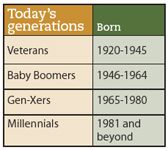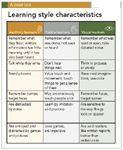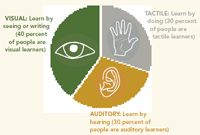All hands, eyes, and ears on deck
Here's how to make your CE sessions effective for different learning styles.
Associates, you probably feel angst when you suggest an improvement to a hospital process, only to be shut down by the practice owner who thought you were insulting her leadership abilities. And practice owners, you're baffled by your associate who leaves promptly at 5 p.m. and never takes cases after closing time. Here's the rub: These behaviors are not necessarily the result of obstinacy or a poor work ethic. They may just be generational differences.
The variety of generations and personality types in the workforce today means you need to examine how you're communicating. And because the four generations in the workplace (see "Today's generations") live and interact differently, communication challenges pop up and affect how the team works together.
Keeping these generational differences in mind is important when you're planning team CE sessions. Not only does everyone in your practice represent a different generation, everyone also has a different learning style. So to effectively educate your team members, you'll need to overcome personality differences as well as generational barriers.

This article, based on the findings in Benchmarks 2008: A Study of Well-Managed Practices, discusses conflicting communication styles of generations in the workplace, the opportunities that can arise from communication gaps, and suggestions for mitigating miscommunication.
Keep it together
Dr. Brent Cook of Kingsbrook Animal Hospital in Frederick, Md., says teams tend to fall apart when team members have no opportunity to be heard. So get them involved, especially when it comes to CE. Each year, Dr. Cook's staff has a chance to attend CE. Licensed technicians attend a national conference and other staff members attend local events. While attending a conference, team members go to dinner together every night and share what they learned that day.
If your practice can't afford to send everyone to a conference, internal meetings are a great tool. Dr. Cook suggests soliciting ideas on CE topics and presentation options. And if team members are interested, allow them to prepare and present on the topics they're knowledgeable about. Create a three-, six-, or 12-month CE calendar using employees' suggestions so you know the focus of the meeting ahead of time and have time to prepare and delegate responsibility. Team involvement boosts employees' enthusiasm for CE, and, as a result, they buy into the process. "Employees are excited about exploring an area they've picked themselves, and they share more information with other employees this way," Dr. Cook says.
You can plan a great CE meeting just by knowing who's coming, says Cindy Mims-Nash, hospital administrator at Oakhurst Veterinary Hospital in Oakhurst, N.J. Mims-Nash says that often an employee's lack of interest in a CE session is due to the fact that the content doesn't match his or her learning needs.
To ensure that visual, auditory, and tactile learners (see "Learning style characteristics") grasp a new procedure or understand how to make a recommendation to a client, make sure elements of your presentation appeal to the different learning styles. Try an oral presentation (to appeal to the auditory learners) with props (for the visual and tactile learners) and provide a handout afterward (everyone benefits).
You might also give a quiz at the end of the session. This promotes a little healthy competition between departments—and teamwork within groups—by presenting awards for the highest scores.
Learn about differences
Educating your team on the concept of work-life balance, while not clinical or client-related CE, is of vital importance. Team members from more recent generations place a higher emphasis on balancing work with the rest of their lives. For Veterans and Baby Boomers, work is the primary concern of life, but the Gen-Xers and Millennials place emphasis on life outside of work. Their lifestyles define the jobs they hold, unlike their parents, whose work dictates the lives they lead.

Learning style characteristics
These generational differences can help explain varying attitudes toward work in your practice. Promote a healthy balance in your employees, and you'll benefit. Come to work on time and go home on time. Of course, you may have the occasional 60-hour week, but if you set the example on good days, employees will follow on difficult days.
Associates and team members, you have a responsibility, too. Your job may be just a job and you love it, but to the owner, it's more. The practice is a large portion of her life savings and it's something she's proud of. So when you're asked to stay late, or hear the speech on "how we do things here," don't roll your eyes. You'll have a better chance of being heard when the owner is under less stress. And whether they say so or not, owners appreciate it.
Can you hear me now?
Clear communication is necessary for smooth operations. Teaching your staff how to maintain work-life balance and develop hospital-wide teamwork is just as important as teaching them your medical protocols. A CE program improves the quality of medicine, boosts morale, and grows the bottom line. But there's no one-size-fits-all solution to your communication woes. "It takes many spokes on a wheel to make it go around smoothly," says Mims-Nash. "At the end of the day, each spoke contributes in a different way to achieve the smooth ride." To improve your communication skills, remember to:
Be patient. The whole team is trying to help the practice run smoothly. Take a deep breath and realize that although methods may vary, you're all working toward the same goal.
Understand perspectives. For example, a Baby Boomer will be more likely to arrive at work first and leave last, simply because work takes priority. A Gen-Xer may want to try new approaches to established procedures, not intending to challenge the old way but to discover options that better use his or her skills.
Persevere. Reach out to employees and help them reach out to each other.
Practicing these steps won't immediately solve your communication troubles, but proactive communication will help encourage effective working relationships. And that benefits everyone on the team.
The bottom line
Employees from different generations have different learning styles and views about their jobs. To smooth out communication:
> Identify your employees' learning styles (see Learning style characteristics).
> Encourage employees to develop their own ideas for team CE and share what they learn at conferences with others.
> Be patient and persevere. Help employees reach out to each other. It takes time.
A closer look
Lend me your ear
By Denise Tumblin, CPA
The way a person prefers to learn is called his or her learning style. There is no right or wrong, good or bad learning style. It has nothing to do with intelligence or skills and everything to do with the way a person's brain works. And since everyone learns differently, understanding learning styles will help you and your team members become better mentors and teachers and tailor your internal CE programs appropriately. Here are the three main categories:

Lend me your ear
Team building strategies
For an exercise that will shed light on how your team prefers to learn, ask your employees—doctors included—to take a learning style inventory at www.engr.ncsu.edu/learningstyles, then discuss the results.
Denise Tumblin, CPA, is a Veterinary Economics Editorial Advisory Board member. Helen Hoekstra is a financial and valuation analyst. Both work at Wutchiett Tumblin and Associates in Columbus, Ohio. Send questions or comments to ve@advanstar.com.